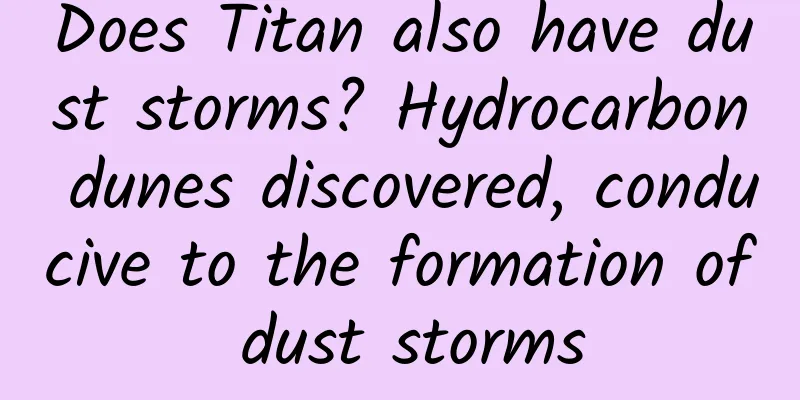Does Titan also have dust storms? Hydrocarbon dunes discovered, conducive to the formation of dust storms

|
[Mobile software: Bo Ke Yuan] In a new study published in the journal Geophysical Research Letters, meteorological conditions on Saturn's large moon Titan appear to be favorable for the formation of dust storms. Titan is the most Earth-like, strange and distant satellite world in the solar system. If true, these dry cyclones may be the main promoter of dust on Titan's surface, just like on Mars. The Cassini spacecraft toured the Saturn system between 2004 and 2017, observing dunes in the moon's equatorial region, covering up to 30% of the surface, and observed a large dust storm. "The dust on Titan's dunes is thought to come from hydrocarbon aerosols in Titan's atmosphere," said Brian Jackson, a planetary scientist at Boise State University in Idaho and lead author of the new study. "It likely has a plastic texture, unlike the more familiar grit found on Earth or Mars. Rare large dust storms look impressive, but dust storms send more total dust into the atmosphere, even on Earth, where winds are more influential than on Mars or Titan." "Winds on Titan's surface are usually very weak and probably not that strong unless a large storm passes through, so dust storms could be one of the main dust transport mechanisms on Titan. Dust storms have not been observed on Titan, but the authors of the new study predicted their possible presence by applying a meteorological model to data obtained from the surface during a brief visit by the Cassini Huygens probe in 2005. Dust storms form in dry, calm conditions when sunlight warms the ground and near-surface air." Mysterious dust Rising warm air creates visible vortices in which sand and dust are picked up. Dust storms share some of the same physical properties as tornadoes, but they are always dry and don't get as large and destructive as tornadoes, but scientists don't fully understand how dust storms work. When you plug in numbers for how much dust a dust storm should pick up based on the wind speeds you see, they seem to be able to pick up more dust than expected. There may be some other mechanism that helps pull up the dust, or the formula is wrong. Researchers are making an in-depth observation effort by chasing dust storms in southeastern Oregon's Alvord Desert using small drones carrying weather instruments. During the Martian summer, unusually dry conditions on the Red Planet produce many dust storms, when they can grow large, up to 8 kilometers (5 miles) high. Because the Martian atmosphere is so thin, even 200-mile-per-hour winds cause only minor vibrations. This makes the dust-raising abilities of dust storms very important to the global movement of dust on Mars. "We can watch dust devils sweep across the surface of Mars and see what their internal structure looks like, but that doesn't tell us how much dust they kick up. The Martian atmosphere is really, really dusty, and dust plays a big role in the climate. Dust devils are probably one of the most important mechanisms for kicking up dust, if not the main mechanism. Dust devils on Titan, if they exist, might be just as important, even though Titan's surface winds are generally mild for the exact opposite reason: Titan's atmosphere is 1.5 times denser than Earth's, but Titan's gravity is only one-seventh that of Earth's, which makes Titan's atmosphere hard to move around." It's just this big, fluffy atmosphere. When there's so much air, it's hard to keep it agitated, so Titan's surface doesn't usually get very windy. Like Earth's atmosphere, Titan's atmosphere is mostly nitrogen, but it also contains appreciable amounts of ethane and methane, the main components of natural gas. Titan is the only body in the solar system besides Earth where scientists have observed evidence of flowing rivers and liquid surface lakes, but scientists think these Earth-like features on cold and distant Titan are not water, but liquid hydrocarbons. The new study's dust storm predictions may have to wait until NASA's Dragonfly mission arrives in 2034 to be confirmed. Getting buffeted by a dust storm while exploring Titan's surface is unlikely to cause trouble for the large octocopter. Boco Park | Research/From: American Geophysical Union Reference journal Geophysical Research Letters BoKeYuan|Science, technology, research, popular science Follow [Bokeyuan] to see more beautiful cosmic science |
<<: Popular Science | The "little secret" of choosing down jackets
Recommend
E-commerce platform HighstreetWatchApp
Source code introduction: This project is an appl...
The reason I advise you to eat more fresh walnuts, just one is enough!
Recently, I am really envious of people from Shaa...
Pride and Prejudice: Luo Yonghao's slap in the face and Hammer's return to the ground
Luo Yonghao was slapped in the face again, and th...
An explosion! Send us into space? Exploring the energy secrets of spacecraft
Endless explosions could send hypersonic vehicles...
Methods to boost the Wenchang position
Wenchang Tower and Wenchang Lantern can boost the...
RAPOO D5 "three-in-one" experience
In terms of functional expandability, mobile powe...
Ibuprofen has become very popular recently. Do you know its origin?
In the fight against the COVID-19 pandemic, ibupr...
A couple died of hypothermia after climbing the top of an ice crystal at night! How terrible is hypothermia?
Audit expert: Wang Xuejiang Professor of Pathophy...
Information flow advertising is ineffective because you don’t understand these!
1. What are the pain points of performance market...
5 key points of Mixue Ice City’s social media marketing operations
Mixue Bingcheng sparked heated discussions on the...
Even Google Play Store can’t tell the difference between real and fake WhatsApp
Let me tell you a shocking news: a pirated softwa...
When shampoo is used up, can I use shower gel instead? The answer is confusing...
In daily life, we will inevitably encounter some ...
What kind of zoo could make an emotionally stable capybara become anxious?
Capybara is undoubtedly one of the hottest animal...
Absolutely useful information! Nine abnormal ways of operating Taobao and Tmall
Text/E-commerce consultant Lao Lu First summarize...
Is breast milk no longer nutritious after 10 months? Can smoking prolong your life? Here are the scientific rumors for March
1. Alcohol and hand sanitizer can inactivate noro...









